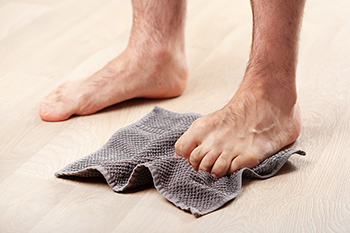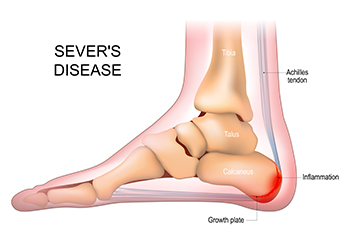Dallas (214) 340-8885
Athens (903) 677-9090
Gun Barrel City (903) 887-4341
Dallas (214) 340-8885
Athens (903) 677-9090
Gun Barrel City (903) 887-4341

Peripheral artery disease, or PAD, is a vascular condition characterized by narrowed arteries, limiting blood flow to the extremities. Recognizing the signs of PAD, particularly in the feet, is essential for early detection and treatment. One notable symptom is intermittent claudication, causing pain or cramping in the legs during physical activity. Reduced blood flow can result in coolness or numbness in the feet, along with weakened or absent pulses in the ankles and feet. Slow-healing wounds or sores, especially on the feet, may indicate compromised circulation. Changes in skin color, such as paleness or a bluish tint, could also be observed. Additionally, individuals with PAD may experience hair loss on their feet and legs, as well as shiny or thin skin. Ignoring these signs can lead to serious complications, including tissue damage and an increased risk of amputation. If you have PAD, and your feet are affected, it is suggested that you consult a podiatrist who can help you to manage this condition.
Peripheral artery disease can pose a serious risk to your health. It can increase the risk of stroke and heart attack. If you have symptoms of peripheral artery disease, consult with Dr. Jonathan Kletz from Texas Foot Works. Our doctor will assess your condition and provide you with quality foot and ankle treatment.
Peripheral artery disease (PAD) is when arteries are constricted due to plaque (fatty deposits) build-up. This results in less blood flow to the legs and other extremities. The main cause of PAD is atherosclerosis, in which plaque builds up in the arteries.
Symptoms
Symptoms of PAD include:
It is important to note that a majority of individuals never show any symptoms of PAD.
Diagnosis
While PAD occurs in the legs and arteries, Podiatrists can diagnose PAD. Podiatrists utilize a test called an ankle-brachial index (ABI). An ABI test compares blood pressure in your arm to you ankle to see if any abnormality occurs. Ultrasound and imaging devices may also be used.
Treatment
Fortunately, lifestyle changes such as maintaining a healthy diet, exercising, managing cholesterol and blood sugar levels, and quitting smoking, can all treat PAD. Medications that prevent clots from occurring can be prescribed. Finally, in some cases, surgery may be recommended.
If you have any questions, please feel free to contact one of our our offices located in Dallas, Athens, and Gun Barrel City, TX . We offer the newest diagnostic and treatment technologies for all your foot care needs.

Experiencing the discomfort of plantar fasciitis should not keep you sidelined from the activities you enjoy. Along with professional guidance from a podiatrist, integrating targeted exercises into your daily routine can provide significant relief from the heel pain that accompanies this repetitive stress injury. Start with gentle stretches like the towel stretch, where you sit with legs extended, a towel wrapped around the ball of your foot, while pulling it towards you, and feeling the stretch along your calf and underfoot. Calf stretches, which are done by standing facing a wall with one foot behind the other and leaning forward, can help to alleviate tension in the calf muscles. Additionally, the plantar fascia and calf stretch, performed on a step with heels hanging off the edge, targets both the plantar fascia and calf muscles. For strengthening, try towel curls, scrunching a towel with your toes while seated, or marble pickups, using your toes to lift marbles and place them into a cup. With dedication and consistency, these exercises can play a vital role in managing plantar fasciitis and getting you back on your feet. Remember to start slowly, and gradual increase intensity. It is suggested you consult with your podiatrist before beginning any new exercise regimen.
Exercising your feet regularly with the proper foot wear is a great way to prevent injuries and build strength. If you have any concerns about your feet, contact Dr. Jonathan Kletz from Texas Foot Works. Our doctor can provide the care you need to keep you pain-free and on your feet.
Exercise for Your Feet
Exercise for your feet can help you gain strength, mobility and flexibility in your feet. They say that strengthening your feet can be just as rewarding as strengthening another part of the body. Your feet are very important, and we often forget about them in our daily tasks. But it is because of our feet that are we able to get going and do what we need to. For those of us fortunate enough to not have any foot problems, it is an important gesture to take care of them to ensure good health in the long run.
Some foot health exercises can include ankle pumps, tip-toeing, toe rises, lifting off the floor doing reps and sets, and flexing the toes. It is best to speak with Our doctor to determine an appropriate regimen for your needs. Everyone’s needs and bodies are different, and the activities required to maintain strength in the feet vary from individual to individual.
Once you get into a routine of doing regular exercise, you may notice a difference in your feet and how strong they may become.
If you have any questions please feel free to contact one of our our offices located in Dallas, Athens, and Gun Barrel City, TX . We offer the newest diagnostic and treatment technologies for all your foot and ankle needs.

Active children often experience heel pain, a common ailment that can stem from various factors related to growth and physical activity. One prevalent condition associated with heel pain in children is Sever's disease, also known as calcaneal apophysitis. This condition occurs when the growth plate at the back of the heel becomes inflamed due to repetitive stress and strain, typically during periods of rapid growth. Signs of Sever's disease include heel pain, particularly during physical activities like running or jumping, as well as tenderness and swelling in the affected area. Children may also exhibit a limp or reluctance to participate in sports and activities they once enjoyed. Parents and caregivers need to recognize these signs and seek appropriate medical attention to manage symptoms and prevent further complications. With proper rest, supportive footwear, and guided physical activity, children can recover from Sever's disease and resume their active lifestyles with minimized discomfort. If your active child has heel pain, it is strongly suggested that a podiatrist is contacted who can diagnose and treat Sever’s disease.
Sever's disease often occurs in children and teens. If your child is experiencing foot or ankle pain, see Dr. Jonathan Kletz from Texas Foot Works. Our doctor can treat your child’s foot and ankle needs.
Sever’s Disease
Sever’s disease is also known as calcaneal apophysitis, which is a medical condition that causes heel pain I none or both feet. The disease is known to affect children between the ages of 8 and 14.
Sever’s disease occurs when part of the child’s heel known as the growth plate (calcaneal epiphysis) is attached to the Achilles tendon. This area can suffer injury when the muscles and tendons of the growing foot do not keep pace with bone growth. Therefore, the constant pain which one experiences at the back of the heel will make the child unable to put any weight on the heel. The child is then forced to walk on their toes.
Symptoms
Acute pain – Pain associated with Sever’s disease is usually felt in the heel when the child engages in physical activity such as walking, jumping and or running.
Highly active – Children who are very active are among the most susceptible in experiencing Sever’s disease, because of the stress and tension placed on their feet.
If you have any questions, please feel free to contact one of our our offices located in Dallas, Athens, and Gun Barrel City, TX . We offer the newest diagnostic and treatment technologies for all your foot and ankle injuries.

In the hustle and bustle of our daily lives, the importance of wearing appropriate shoes often takes a backseat. However, the effect of choosing the right footwear for your workday cannot be overstated. The shoes you wear play a pivotal role in supporting your feet and maintaining overall well-being. Wearing ill-fitting or improper shoes can lead to a cascade of issues, from discomfort and fatigue to more severe problems like joint pain and posture issues. Investing in the right pair of shoes tailored to your work environment is an investment in your health and productivity. The correct shoes provide adequate support, preventing strain on your feet and lower limbs throughout the day. By prioritizing proper footwear, you not only enhance your physical comfort but also contribute to a more focused and effective work routine, setting the foundation for a successful and pain-free professional journey. If you experience any type of foot pain as a result of the shoes you wear while working, it is suggested that you consult a podiatrist who can offer treatment options.
While working on the feet, it is important to take the proper care of them. For more information about working on your feet, contact Dr. Jonathan Kletz from Texas Foot Works. Our doctor will treat your foot and ankle needs.
Working on Your Feet
Standing on your feet for long periods of time can cause stress and pain in your feet. Your whole body may experience change in terms of posture, back pain, bunions, callouses and or plantar warts. There are ways to avoid these conditions with proper foot care, smart choices and correct posture.
Positive Changes
Negative heeled shoe – Choosing this shoe type places the heel slightly lower than the ball of the foot. These are great for overall foot health. Find shoes that fit you correctly.
Go barefoot – Our feet were not designed to be enclosed for all hours of the day. Try to periodically expose your feet to air.
Eliminate Pain
Foot Exercises – Performing simple exercises, incorporating yoga and doing stretches are beneficial. This will allow increased blood flow to the area and muscles of the foot.
Achilles tendon – Stretching the foot out flat on the floor will relax the calf muscles and tendon. These exercises can be performed almost anywhere. Make sure you add these exercises to your daily regimen.
With a little bit of this information and knowing more about foot health, you will notice changes. Foot stretches and proper footwear will help with pain and prevent further issues.
If you have any questions please feel free to contact one of our our offices located in Dallas, Athens, and Gun Barrel City, TX . We offer the newest diagnostic and treatment technologies for all your foot and ankle needs.